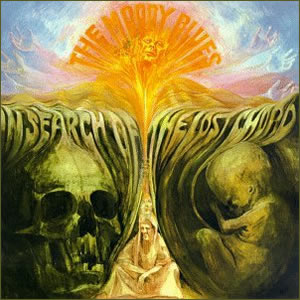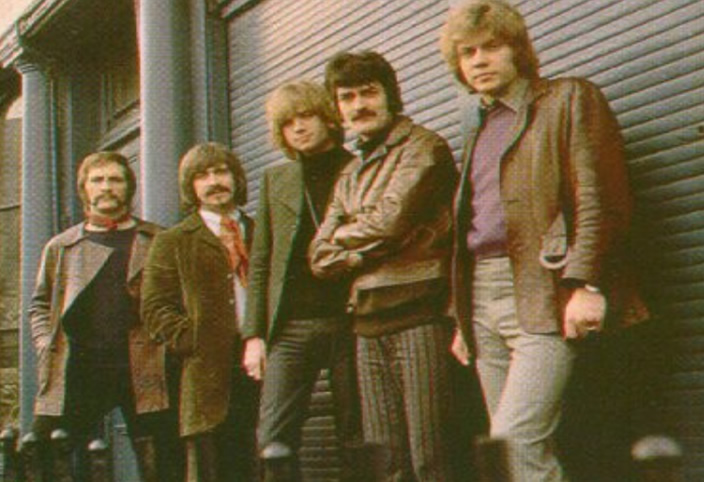In Search of the Lost Chord
by The Moody Blues
Buy In Search of the Lost Chord
 In Search of the Lost Chord is a deeply philosophical album by The Moody Blues, built around the concepts of quest and discovery. Musically, the album builds on the rich arrangements of Days of Future Passed with the exception being the lack of use of a full orchestra. The members of the group played the approximately 33 instruments themselves, exploring eclectic sounds from the Indian sitar and tambura to the orchestral oboe, flute, harp, and cello. But at its core In Search of the Lost Chord is still a rock album, accented by the same mix of British pop, psychedelia, and spoken-word poetry that the Moody Blues used on their previous album.
In Search of the Lost Chord is a deeply philosophical album by The Moody Blues, built around the concepts of quest and discovery. Musically, the album builds on the rich arrangements of Days of Future Passed with the exception being the lack of use of a full orchestra. The members of the group played the approximately 33 instruments themselves, exploring eclectic sounds from the Indian sitar and tambura to the orchestral oboe, flute, harp, and cello. But at its core In Search of the Lost Chord is still a rock album, accented by the same mix of British pop, psychedelia, and spoken-word poetry that the Moody Blues used on their previous album.
Bringing together these vast worlds was the mellotron of keyboardist Mike Pinder, a device which could mimic dozens of instrumental sounds. Pinder had worked at the company which developed the instrument in the early 1960s and later introduced the mellotron to John Lennon and Paul McCartney, who used it on the Beatles’ 1966 single “Strawberry Fields Forever”. The long and dreamy notes of this instrument perfectly fit the psychedelic mood of this album with songs about Timothy Leary, the astral plane, and philosophical “lost chord”.
While the album’s approach seemed to be an experiment to see how far the group could go with any instruments they could find, the production of Tony Clarke kept it sounding more cohesive than many of its thematic cousins of the era. This was accomplished by focusing on the simple nearly as much as the complex, which keeps it from falling into a haze of obscurity.
 In Search of the Lost Chord by The Moody Blues |
|
|---|---|
| Released: July 26, 1968 (Reprise) Produced by: Tony Clarke Recorded: Decca Studios, London, January – June 1968 |
|
| Side One | Side Two |
| Departure Ride My See-Saw Dr. Livingston, I Presume House of Four Doors (Part 1) Legend of a Mind House of Four Doors (Part 2) |
Voices In the Sky The Best Way to Travel Visions of Paradise The Actor The Word Om |
| Band Musicians | |
| Justin Hayward – Guitars, Keyboards, Sitar, Vocals Mike Pinder – Piano, Mellotron, Harpsichord, Cello, Harp, Tambura Ray Thomas – Flute, Saxophone, Oboe, French Horn, Vocals John Lodge – Bass, Cello, Vocals Graeme Edge – Drums, Percussion, Vocals |
|
A dramatic rising sound behind poetic spoken word “Departure”, gets more and more desperate and intense before climaxing at the end. Written and recited by drummer Graeme Edge, the 48 second piece acts as an intro to “Ride My See-Saw”. Perhaps the most commercially known track on the album, “Ride My See-Saw” is a straight forward rocker with rhythmic motion and great bass by John Lodge, who was also the song’s composer. The song was released as a single but failed to chart initially (the song went to #3 on the UK charts when re-released in 1972). “Dr. Livingstone, I Presume” comes in as a bouncy English children’s song but soon matures to a more complex rock arrangement during the “we’re all looking for someone” refrain, which is sandwiched by two interesting guitar riff intervals. This song was written by multi-instrumentalist Ray Thomas and explores several historical figures along with the missionary explorer, Dr. David Livingstone.
Lodge’s “House of Four Doors” is a two-part, mellotron-infused, psychedelic ballad with rich vocal harmonies and creaking door effects, which each bring the listener through a different era of development in European music. The first features an acoustic and flute section and seems to preview some of the pastoral music of the future band Genesis, especially on Selling England by the Pound. Next is chamber music, led by a harpsichord and cello, followed by classical music featuring Pinder on piano, and finally the passage to the “futuristic” music of “Legend of a Mind”. One of the most creative Moody Blues tracks ever, “Legend of a Mind” is vocally and lyrically intriguing with contemporary lyrics about Timothy Leary, a Harvard professor and LSD enthusiast;
He’ll fly his astral plane, Takes you trips around the bay
Brings you back the same day, Timothy Leary…”
The song is also musically excellent, moving from soft acoustic verses to a more upbeat chorus to the guitar riff interludes to the fast waltz of the bridge before settling in with a long flute section by Thomas, who also composed the song and sings lead vocals. “House of Four Doors” (Part 2) is a short reprise led by the drum beat of Edge, to complete the mini suite and the first side.

Side Two begins with three absolute gems. Hayward’s pleasant and mellow “Voices in the Sky” is one of the most melodic songs on the album, with exquisite melodies during the verses. This simple acoustic song contains just enough musical splashes of flute, mellotron, and bass to give it a slight edge but is otherwise almost as straightforward and romantic as the previous year’s “Nights In White Satin”. While Pinder’s “The Best Way to Travel” goes in the opposite direction, it is just as interesting. It comes like an overloaded country song but with strong bass, reverb effects, and steady, droning drums. This Pink-Floyd influenced song suddenly halts for a middle organ section before the whole arrangement returns in a long, cosmic fade-in for the resolving conclusion. “Visions of Paradise” is a Hayward and Thomas collaboration, which features little else than Thomas’s flute riff and Hayward’s softly picked acoustic. Apparently resuming the drug-trip theme, this song may be even further “out there” than “The Best Way to Travel” with a surreal perception of paradise.
The deep, rich and sleepy arrangement of “The Actor” is driven by rather upbeat acoustic riff and Lodge’s accompanying bass. This is followed by Lodge reciting Edge’s second poem “The Word” with a naked vocal that interprets the album title’s meaning;
Two notes of the chord, that’s our full scope / But to reach the chord is our life’s hope / To name the chord is important to some…”
So they give it a word, and the word is “Om”. The final track by Pinder is canvased by very calm Eastern music for the vocals, solo during verses and deeply harmonized during choruses. Beyond the very interesting beginning, the rest of this six and a half minute track is more soundscape than song, including a deeply harmonized hummed reprise of “Ride My See Saw” at the very end of the song and album.
In Search of the Lost Chord peaked at #23 on the US album charts and #5 in the UK. 45 years later it continues to be highly regarded as a gem from the psychedelic/space rock era. Space exploration would go on to become the theme of the Moody Blues’ next album in 1969, To Our Children’s Children’s Children, dedicated to the Apollo 11 mission.
~
Part of Classic Rock Review’s celebration of 1968 albums.





May 7, 2020 @ 2:05 am
7 May, 2020:
I happened to be listening to this beautiful, ahead of it’s time album today and during “Dr. Livingstone I presume”, I was amazed to hear the reference to Scott of the Antarctic and Polar bears. Having heard the song dozens of times over the decades, I was amused to hear this inaccuracy and the fact that I, nor anybody seems to have ever picked up the fact that there are no polar bears in the Antarctic!